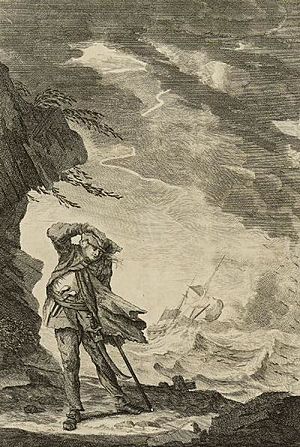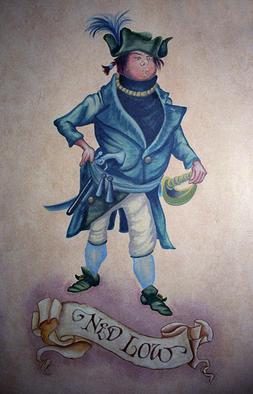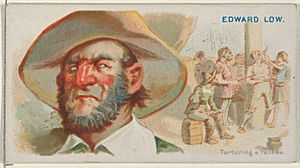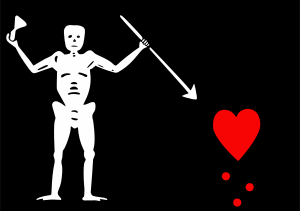Edward Low facts for kids
Quick facts for kids
Edward Low
|
|
|---|---|

Capt Edward Low in ye Hurricane which He and All the Crew had Like to Perish'd by J Nicholls and James Basire, hanging in the National Maritime Museum in London
|
|
| Born | 1690 |
| Died | Disputed (1724, or 1739+) Place of death Disputed
|
| Piratical career | |
| Nickname | Ned Low |
| Type | Pirate |
| Years active | c.1721–c.1724 (possibly to 1739+) |
| Rank | Captain |
| Base of operations | Atlantic Caribbean |
| Commands |
|
Edward "Ned" Low (1690–1724) was a well-known pirate from England. He sailed the seas in the early 1700s, during the end of the Golden Age of Piracy. Edward Low was born in Westminster, London, and grew up in a poor family.
As a young man, he moved to Boston, Massachusetts. After his wife passed away in 1719, he became a pirate two years later. He operated his ships near New England, the Azores, and in the Caribbean Sea.
Low was the captain of several ships. He often sailed with a small group of three or four vessels. During his short career, Low and his pirate crews captured many ships. He was known for being one of the most feared pirates of his time.
Contents
Early Life of Edward Low
According to a book called A General History of the Pyrates by Charles Johnson, Edward Low was born in Westminster, London, England, in 1690. He was described as someone who didn't read or write much. He was also known for getting into arguments.
As a young person, he often caused trouble in the streets. His family also had a history of breaking rules. His brother, Richard, was once caught for a crime and faced serious consequences in 1707.
Life in Boston
As he got older, Low decided to leave England. He traveled alone to the New World around 1710. He spent a few years in different places before settling in Boston, Massachusetts. In 1714, he married Eliza Marble. They had a son who died young, and then a daughter named Elizabeth in 1719.
Sadly, Eliza passed away during childbirth. This loss deeply affected Low. Later, as a pirate, he often spoke about missing his daughter. He would also let married men return home and allowed women to go back to port safely.
At first, Low worked honestly as a rigger. In 1722, he joined a group of twelve men on a ship going to Honduras. They planned to collect wood to sell in Boston. One day, Low became angry when he was told to wait for food. He tried to shoot the captain but missed, hitting another person instead.
After this event, Low and his friends had to leave the ship. The next day, Low led his group, which included Francis Farrington Spriggs, who also became a famous pirate. They took over a small ship near Rhode Island. Low and his crew then decided to become pirates. They were determined "to go in her, make a black Flag, and declare War against all the World."
Pirate Adventures
First Steps as a Pirate
Low used his newly captured ship to wait along a busy shipping route between Boston and New York. Within a few days, he and his crew seized another ship from Rhode Island. They took its goods and cut its ropes to prevent it from quickly returning to port to warn others. He then captured several unarmed merchant ships near Port Rosemary.
Low sailed south and began operating near Grand Cayman. He became a lieutenant to the pirate George Lowther, who captained a ship called the Happy Delivery. After Lowther's ship was damaged, they moved to a ship named the Ranger. Lowther's crew grew as more sailors joined them.
After many successful raids, Lowther captured a larger ship called Rebecca in May 1722. He gave this ship to Low to command. With a crew of 44, Low and Lowther decided to go their separate ways as friends.
Becoming a Pirate Captain
In June 1722, Low and his crew attacked thirteen fishing boats. These boats were anchored in Port Roseway, Shelburne, Nova Scotia. Even though he was outnumbered, Low raised his Jolly Roger flag. He announced that no mercy would be given if anyone fought back. The fishing fleet surrendered, and Low's men robbed every vessel.
Low chose the largest ship, an 80-ton schooner, and renamed it The Fancy. He armed it with 10 guns and made it his main ship. He then sank the other captured ships and left the Rebecca.
The Boston News-Letter newspaper published a list of those captured by Low in July 1722. Some fishermen were forced to join Low's crew. One of them was Philip Ashton, who later escaped in May 1723. Ashton wrote a detailed story about his time on Low's pirate ship. He was often beaten and threatened because he refused to become a pirate.
Low's main strategy was to use false colours. This meant he would fly the flag of a friendly nation to trick ships into getting close. Off the coast of St John's, Newfoundland, Low almost made a mistake. He thought a fully armed warship was a fishing boat and barely escaped.
He then moved to Conception Bay, capturing several boats around the Grand Banks southeast of Newfoundland. After that, he sailed across the Atlantic Ocean to the Azores. There, he captured a French (or Portuguese) ship called a pink. This ship was once a warship. Low rearmed and refitted it, naming it the Rose Pink and making it his new main ship.
He also captured an English ship with two Portuguese passengers. Low's crew treated them very cruelly until they died. He then sailed to the Canaries, Cape Verde, and then back to the coast of Brazil. Bad weather forced him to turn back.
Low gave up his plans to raid the rich shipping trade off Brazil. He then moved to the Caribbean. A British ship's mate, George Roberts, described meeting Low. Roberts' ship was captured by Low's fleet, and Low was now calling himself "Commodore."
The Rose Pink Sinks
About 220 kilometers east of Surinam, Low and his two ships, the Rose Pink and the Fancy, stopped. They needed to clean the outside and bottom of their boats, a process called careening. Pirates did not have access to special dry docks.
Low was still learning and ordered too many men to work on the outside of the Rose Pink. The ship tilted too much. Its portholes were open, and water rushed in, causing the ship to sink. Two men were lost with the ship. The Rose Pink had been carrying most of their supplies. Low was now on a smaller ship, a schooner called the Squirrel. His crew had to strictly limit their fresh water to about 275 milliliters per person per day.
Low's fleet could not reach their first goal of Tobago due to light winds and strong currents. They eventually made it to Grenada, a French island. Low hid most of his men below deck. He was allowed to send men ashore for water. The next day, a French ship came to investigate. Low's men came out of hiding and captured it.
Low now commanded the captured ship, which he renamed the Ranger. He gave the schooner Squirrel to Spriggs, his second-in-command. Spriggs renamed it the Delight. Spriggs then sailed away in the middle of the night with a small crew. This happened after a disagreement with Low about how to discipline one of Spriggs' crew members.
Early 1723 Raids
Low's new fleet captured many more ships. One ship, which Low kept, he named the Fortune. During a trial for some of Low's crew members in July 1723, a sailor from the Fortune said Low stripped his boat of gold worth about £150.
After this, Low's fleet captured a Portuguese ship called the Nostra Signiora de Victoria in January 1723. The Victoria's captain let a bag with about 11,000 gold coins (worth about £15,000) fall into the sea. He did this rather than let the pirates take it. In his anger, Low harmed the remaining crew. Even Low's own men described him as "a maniac and a brute."
Low, like other pirates, tried to scare his victims into giving up. He would threaten to hurt them. The crew of a targeted ship would often stop their officers from fighting back. They were too afraid of what Low might do.
A ship called the Unity was added to the fleet. It was used as a smaller support ship. But it was left behind during a fight with a warship named the Mermaid. As Low became more successful in the Caribbean, his bad reputation grew. Eventually, a reward was offered for his capture. Low then sailed to the Azores, again working with Charles Harris. As they caused trouble in the Azores, the authorities increased their efforts to catch Low.
A Major Defeat
Low, Harris, and their ships left the Azores for the Carolinas. On June 10, 1723, they suffered a big defeat. They fought against HMS Greyhound, a heavily armed warship. The Greyhound had been sent to hunt down Low and his fleet. Low fled in the Fancy with a small crew and a lot of gold. He headed back to the Azores, leaving Harris and the Ranger behind.
Twenty-five of the Rangers crew, including the ship's doctor, were put on trial. This happened between July 10 and July 12. The captain of the Greyhound gave evidence about the battle. The men were executed for piracy near Newport, Rhode Island, on July 19, 1723. Harris was sent back to England and executed. When the Greyhounds captain returned to New York, he was honored for helping bring some of Low's crew to justice.
The End of Low's Pirate Career
Low, still captaining the Fancy, sailed north. He captured a whaling ship far out at sea. He left the whaler's crew adrift with no supplies. He intended for them to starve. Luckily, they reached Nantucket, Massachusetts, after a difficult journey.
Staying off the coast of North America, Low's crew took a fishing boat near Block Island. Low harmed the ship's master and sent the crew ashore. When he captured two more fishing boats near Rhode Island, his actions became so extreme that his own crew refused to follow his orders.
Heading south again, Low captured a French ship and a large merchant ship called the Merry Christmas in late June 1723. After his defeat by the Greyhound, Low became especially cruel to his English victims. His fleet of three ships rejoined forces with George Lowther in July. In late 1723, Low and Lowther's fleet captured the Delight off the coast of Guinea. They put fourteen guns on it, and command was given to Spriggs. Two days later, Spriggs and Lowther both left Low. This left him with the Merry Christmas, which now had 34 guns, as his only ship.
What Happened to Low?
There are different stories about how Low died. Captain Charles Johnson, who some believe was Daniel Defoe writing under a different name, said that Low and the Fancy were last seen near the Canaries and Guinea. However, when Johnson wrote his book in 1724, there were no more reports. He mentioned a rumor that Low was sailing for Brazil. Another rumor said Low's ship sank in a storm, and everyone on board was lost. The National Maritime Museum in London says he was never caught and ended his days in Brazil.
Other sources suggest that Low was left adrift by his crew. This happened after Low harmed a sleeping crew member following an argument. His crew then chose a new captain for the Merry Christmas. They would go on to sail with Spriggs in the Caribbean. Low was later rescued by a French ship. When the French authorities found out who he was, he was put on trial and executed in Martinique in 1724.
In March 1726, men from a British warship reported seeing a small boat with nine men. They recognized one of them as Low. The warship could not chase them. This left Low near Roatán, where he was supposedly killed by the native Miskito. Even later, in late 1739, a man identified as "the famous Ned Low" was seen escaping a Spanish fort at Porto Bello. He had been among the fort's gun crews when the city was attacked by British forces.
Pirate Flags
At first, Low used the same flag as his friend Francis Spriggs. Later, he created his own flag. It was a red skeleton on a black background, and it became very well-known. He first flew his own flag in late July 1723. Low also used a green silk flag with a yellow figure of a man blowing a trumpet. This Green Trumpeter flag was used to call his fleet's captains to meetings on his main ship.
Low's Legacy

Edward Low's actions, along with those of other pirates like Edward "Blackbeard" Teach and Bartholomew "Black Bart" Roberts, led to a big increase in military ships. These ships were sent to protect shipping routes. This helped bring an end to the Golden Age of Piracy.
By 1700, European countries had enough soldiers and ships. They could better protect their important colonies in the West Indies and the Americas. Pirates based in the Caribbean were chased away by a new British group of ships. A smaller group of Spanish ships also helped.
Less is known about Low compared to other famous pirates like Teach. Howard Pyle, in an 1880 children's book about pirates, said that Low was very important in the pirate world. He was known for being very cruel. Sir Arthur Conan Doyle described Low as "savage and desperate." The New York Times said "Low and his crew became the terror of the Atlantic."
Low has been featured on stamps and special money in the Caribbean. A postage stamp with Low on it was made by the Cayman Islands in 1975. In 1994, the government of Antigua and Barbuda featured Low and his ship, Rebecca, on a special one hundred-dollar bill made of gold leaf.
"Ned Low" is one of the pirates shown on the Pirates of the Caribbean ride at the Disneyland theme park in California. A copy of Low's flag was used for the flag of the fictional pirate Sao Feng in Disney's Pirates of the Caribbean movies. Ned Low was played by Tadhg Murphy in the TV series Black Sails.
Some places where Low used to hide, like the waters around the Isles of Shoals off New Hampshire, still attract treasure hunters. They hope to find items from the ships he sank.
|
See also








